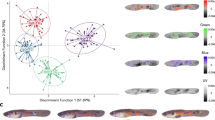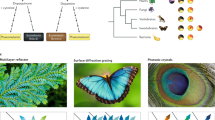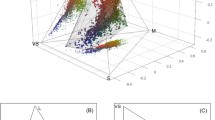Summary
1. Seventeen autosomal colour mosaics in the budgerigar (Melopsittacus undulatus) are described: sixteen of these being “half-siders.” It is suggested that every one of them is the result of the elimination of the “blue” autosome.
2. The chromosome number is 50–60. There are three size classes: theX-chromosome is large: only oneX is present in the female. The very considerable number of small dot-like chromosomes makes it impossible to determine with certainty the actual number, and also to recognise chromosome loss. The large chromosomes show lagging.
Similar content being viewed by others
References
Anon (1933). “Wieder am Erfolg in der Zucht der Halfseiter.”Der Wellensittich, No. 21, 201–2. Hannover-Linden.
Boveri, Th. (1888). “Ueber partielle Befruchtung.”S.B. Ges. Morph. Physiol. München,4, 64–72.
Crew, F. A. E. (1932). “A case of leg colour asymmetry in the fowl.”J. Genet. 25, 359–65.
—— (1933). “A case of non-disjunction in the fowl.”Proc. roy. Soc. Edin. 53, 89–100.
Doncaster, L. (1914).The determination of sex. Cambridge.
Duncker, H. (1928). “Die Vererbung der Farben bei Wellensittichen.”Vögel ferner Länder,1.
Duncker, H. (1933).Dr H. Duncker’s Lists of Budgerigar Matings. Budgerigar Society. Edited by T. S. Elliot. Obtainable from Hon. Sec. of the Budgerigar Society, Mr H. C. Humphries, Bransgore, Headswell Avenue, Bournemouth.
Hampe, H. (1934). “Die wissenschaftlichen Grundlagen der Farbenwellensittichzucht.”Vögel ferner Länder,8, 81–95.
Morgan, T. H. (1905). “An alternative interpretation of gynandromorphism in insects.”Science,21, 632–4.
Morgan, T. H. andBridges, C. B. (1919). “The origin of gynandromorphs.”Publ. Carnegie Instn, No. 278, 87 pp.
Poll, H. (1909). “Zur Lehre von den sekundären Geschlechtscharakteren.”S.B. Ges. naturf. Fr. Berl. 6, 331–58.
Sokolow, N. N. undTrofimow, I. E. (1933). “Individualität der Chromosomen und Geschlechtsbestimmung beim Haushuhn (Gallus domesticus).”Z. indukt. Abstamm.- u. VererbLehre,65, 327–52.
Steiner, H. (1932). “Vererbungsstudien am Wellensittich.”Arch. Klaus-Stift. Vererb.-Forsch. 7, 37–202.
Werner, O. (1927). “The chromosomes of the Indian Runner Duck.”Biol. Bull. 52, 330–72.
—— (1931). “The chromosomes of the domestic turkey.”Biol. Bull. Wood’s Hole,61, 157–64.
Weston, D. (1932). “Another piebald budgerigar.”Budgerigar Bull. 22, 3.
White, M. J. D. (1932). “The chromosomes of the domestic chicken.”J. Genet. 26, 345–50.
Wolthers, J. H. (1933). “Notes from Holland.”Budgerigar Bull. 24, 13–16.
Author information
Authors and Affiliations
Rights and permissions
About this article
Cite this article
Crew, F.A.E., Lamy, R. Autosomal colour mosaics in the budgerigar. Journ of Genetics 30, 233–241 (1935). https://doi.org/10.1007/BF02982238
Issue Date:
DOI: https://doi.org/10.1007/BF02982238




